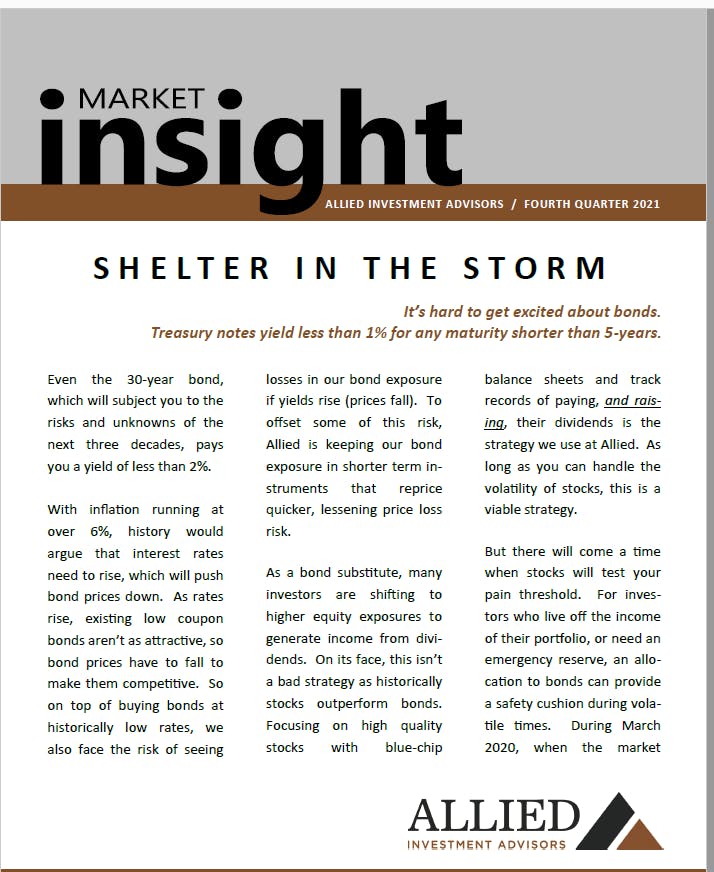Q4 2021: Shelter in the Storm
November 17, 2021
It's hard to get excited about bonds. Treasury notes yield less than 1% for any maturity shorter than 5-years.
Even the 30-year bond, which will subject you to the risks and unknowns of the next three decades, pays you a yield of less than 2%.
With inflation running at over 6%, history would argue that interest rates need to rise, which will push bond prices down. As rates rise, existing low coupon bonds aren’t as attractive, so bond prices have to fall to make them competitive. So on top of buying bonds at historically low rates, we also face the risk of seeing losses in our bond exposure if yields rise (prices fall). To offset some of this risk, Allied is keeping our bond exposure in shorter term instruments that reprice quicker, lessening price loss risk.
As a bond substitute, many investors are shifting to higher equity exposures to generate income from dividends. On its face, this isn’t a bad strategy as historically stocks outperform bonds. Focusing on high quality stocks with blue-chip balance sheets and track records of paying, and raising, their dividends is the strategy we use at Allied. As long as you can handle the volatility of stocks, this is a viable strategy.
But there will come a time when stocks will test your pain threshold. For investors who live off the income of their portfolio, or need an emergency reserve, an allocation to bonds can provide a safety cushion during volatile times. During March 2020, when the market dropped -34% in a matter of weeks, bonds (even low yielding ones) provided shelter in the storm. During this time, the Bloomberg Aggregate Bond Index remained stable, falling only -1%.
Most bear market storms last 36 months. This is the average length of every 20% or more drawdown cycle going back to 1950 (see table below). A full cycle lasts from a market peak, back to when the indexes have recovered, to new highs; or as we like to say peak to trough, back to recovery. The shortest bear was 2020, lasting only 6 months from the peak in February to the August full recovery. The longest cycle was the 1973 drawdown, which the market did not fully recover from until 1980, seven and a half years later (the market nearly put in a new high in 1976, but then went sideways during the late 70s inflation).

To protect your portfolio and keep from having to sell stocks in the middle of a drawdown, it may be necessary to keep 3-5 years’ worth of liquidity and emergency funds in bonds. When the next bear comes around and it’s a matter of when, not if, we’ll see another bear) having an allocation to defensive bonds is important. Low interest rate bonds may not be exciting (most types of insurance aren’t) until the day you need them.
One caveat when it comes to finding the right portfolio allocation: having 3-5 years of income and emergency needs is a good starting point, but a simple question may refine your process: “Is there a dollar amount of loss that will cause me to lose sleep?”
If you open your account statement and see that your $1,000,000 retirement portfolio has fallen $350,000 in value, and is now worth $650,000, will you lose sleep? This is exactly what happened in February and March of 2020. Or, are you comfortable with the quality of your holdings, and understand volatility is part of long-term investing, knowing there will be ups and downs?
Find the dollar number that causes you to lose sleep, and you can back into the right portfolio allocation for your risk tolerance. (Use dollars, not percentages. A percentage loss masks the impact of the cash value on your bottom line.) We would be happy to meet with you and dig into these numbers in more detail.
J.P. Morgan once had a friend who was so worried about his stock holdings that he could not sleep at night. “What should I do about my stocks?” the friend asked? Morgan replied, “Sell down to the sleeping point.”
YEAR END PLANNING
As we approach year end, now is a good time to discuss tax-loss selling to help offset capital gains. It has been a good year in the market, which means many taxable accounts have realized capital gains. It also means that harvestable capital losses are limited, which is a good thing from an investing perspective, but doesn’t help when it comes to tax planning. We’d be happy to review your account with you, seeing if there are any capital loss opportunities to help lessen your tax bill.

Tax rates are also up in the air. The above table shows current capital gains rates (these are long-term rates; short-term gains are taxed as ordinary income).
While these are the currently in force rates, it is worthwhile to compare them to the proposals working through Congress. The furthest along version (the House Democrat’s bill) would raise the top bracket to 25% and lower the thresholds down to $400,000 [Single] and $450,000 [Married Jointly]. This would make the top end capital gains rate 28.8% when we include the Medicare surtax. The proposal also contains a back date feature, making it effective September 13, 2021.
We will be closely watching these bills as they work their way through Congress. In the meantime, we would be happy to coordinate any tax planning with you and/or your accountant.
If you have any questions about your account(s), or if there has been a change in your financial situation or investment objectives, please feel free to contact any member of our team at (406) 839-2037 to schedule a meeting.
Allied Investment Advisors is neither an attorney nor an accountant.
No portion of this newsletter or its content should be interpreted as legal, accounting, or tax advice.

